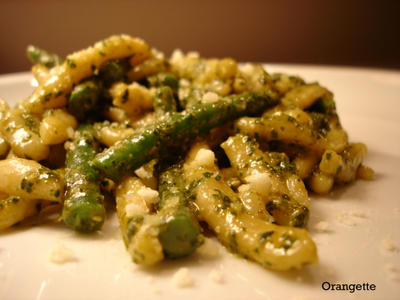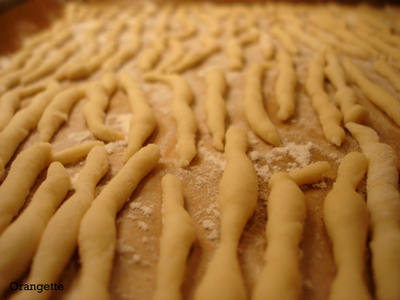Trofie al pesto, with drama and a departure
I may be a crybaby, complete with a mortal fear of needles and a dread of loud noises, but I’m nobody’s drama queen. I like to think of myself as remarkably rational, finely calibrated to operate at a nice, even keel. That’s not to say, though, that I don’t like to spice things up every now and then with, say, a little spontaneous weepiness on public transportation, or maybe a good bout of psychosomatic something. For instance, after my graduation from college, I spent the entire three-day drive from San Francisco to Oklahoma City propped stiffly in the front seat, wracked with heartburn, able to think of nothing but the glorious life I was leaving behind and of the certain doom that lurked in the land of my birth, that place of horrifying humidity and 3.2%-alcohol beer. Obviously, I’d developed some rare and deadly new form of acid-reflux disease. I was dying; there was no other possible answer. You can imagine my delight, then, when I found that my heartburn, along with my anxiety, quickly dissolved into a glass of wine and disappeared into the blessedly powerful air-conditioning vents of my childhood bedroom.
So given my uneasy relationship with drama, I wasn’t entirely surprised to notice that, in the hours after Brandon boarded a plane to return to New York after a miraculous five-week West Coast visit, a strange lump formed in my throat. This was no mere soreness; it was physically hard to swallow. How unoriginal of me, I thought, a little disappointed. I could have aimed for a less clichéd psychosomatic ailment, or at least something that wouldn’t hamper my food consumption. What I really needed was a sudden knock from a New Yorker at my door, but short of that, I would settle for another forkful of trofie al pesto, rustic, homemade, pesto-slicked noodles that go down easy, no matter how big the lump in your throat, real or imagined.

The night before, Brandon and I had hovered together over a flour-dusted counter, turning tiny lumps of pasta dough into rough, nubby spirals. It was activity tailor-made for stretching a moment into slow motion, for cold beer in retro Champagne glasses, for saying goodbye to the curly-haired boy standing next to me in his underwear, an improvised outfit for a warm night in a hot apartment. We churned fresh basil into a lush, nutty paste and blanched slender green beans until steamy; then we coaxed the noodles into the boiling pot; and, sitting down at the table, we pulled the plates up under our chins, trapping noodles and beans between the tines of our forks, sighing our way to the bottom of the bowl and through to the other side, where there waited morning, a jet engine, and that strange tightness that settled around my throat.
Never mind the fact that it turned out to be a simple swollen lymph node—a perfectly rational response, you will note, to a dry Seattle summer’s high pollen count. Somewhere between the last bite of trofie and the next ticket to New York, I’m still a certified crybaby.
Handmade Trofie al Pesto
Adapted from Saveur Cooks Authentic Italian*
Trofie, otherwise known as Ligurian gnocchi, might not be the simplest, quickest pasta shape to make—allow plenty of time, preferably with a glass of something alcoholic and a handsome partner—but they certainly are among the loveliest to eat. In all honesty, ours looked nothing like the picture-perfect corkscrews on the pages of the book, but they were beautiful in their own right, delicate, rustic, and with a good, al dente chew.

We tossed them with green beans, which appealingly mimic the pasta’s shape, size, and texture, but skinny asparagus, lightly blanched, would also be delicious. The original recipe also calls for thinly sliced boiled potatoes to be tossed into the finished dish, but for the sake of summery lightness, we left them out. And just for the record, this is the most delicious, well-balanced basil pesto I’ve ever eaten. Until trying this recipe, I’d been a devoted fan of James Beard’s formula, but well, sorry, big guy.
For the pesto:
2 cups fresh basil leaves, tightly packed
2 heaping Tbs pine nuts
2 cloves garlic, peeled and chopped
Coarse salt
½ cup extra-virgin olive oil
½ cup finely grated Parmigiano-Reggiano, tightly packed, plus more for serving
For the trofie:
3 cups unbleached all-purpose flour, plus extra to work with
1 tsp salt
Water
For finishing:
½ lb haricots verts or small green beans, trimmed (we may have actually used closer to ¾ lb—it’s hard to refrain from gluttony when it comes to sweet summer beans)
For the pesto, place the basil leaves in a tall, thick, narrow glass. Using a citrus reamer, muddle the leaves until they are dark green and pasty; the total volume should reduce by about half, and they should have released quite a bit of liquid. Set aside.
Place the pine nuts, garlic, and salt in the bowl of a food processor fitted with the metal blade attachment, and blend them to a paste. Add the basil and its juices, drizzle in the oil, and process until smooth. Transfer to a bowl, and stir in the Parmigiano.
For the trofie, sift the flour and salt together into a mound on a clean, dry surface. Use your hand to make a well in the center; then pour in about ¾ cup water. Using a fork, gradually incorporate flour from the inside edge of the well into the water. As you stir, add another ½ cup water. When the dough becomes too stiff to work with the fork, flour your hands, and knead until the dough is soft and no longer sticky. [You may find that you need a bit more flour; we added about 2 Tbs.] Push the dough to one side, clean your work surface and your hands, then flour both again, and knead dough until very smooth, about 2-3 minutes more. Cover the dough with a kitchen towel, and set it aside for half an hour.
Clean and flour your hands and the surface again. Pinch off a pea- to chickpea-sized piece of dough, and roll it between your palms to form a fat matchstick. Place it on the floured surface. With your palm facing down, turn your hand up to a 45-degree angle, so that the edge of the pinky-finger side of your palm is resting on one end of the matchstick. Gently but firmly, roll the matchstick back toward you to form a thin spiral. Repeat to use all the dough. This will take practice and time, but be patient. Don’t worry if the trofie are a bit more like worms than like corkscrews: as long as they are all roughly the same thickness and shape, they will be fine. As the trofie are made, transfer them to a lightly floured parchment- or wax paper-lined baking sheet.
Cook the green beans in a large pot of boiling salted water over high heat until tender, about 3-5 minutes. Remove them with a slotted spoon, and cut them into 2-inch lengths. Transfer them to a large serving bowl.
Cook trofie in the same water over high heat until they float to the surface, 3-4 minutes. Reserve a small cupful of the cooking water, and then drain the trofie into a colander and transfer them to the large bowl with the green beans. Add pesto to taste, and splash on a bit of cooking water to obtain a nice, slippery, lightly sauce-like consistency. Taste for salt, and serve, passing a little bowl of grated Parmigiano.
[Note: You will have leftover pesto, but don’t worry: it keeps well, with a thin film of olive oil over its surface, in an airtight container in the fridge, and it freezes fine too. And for further convenience, note that the pasta dough will keep for a day or two in a plastic baggie in the fridge, should you want to split the recipe and enjoy fresh pasta over two nights.]
Serves 6 as a first course, or 4 as a main course.
*Special thanks to B, of Culinary Fool, for helping me to procure this beauty of a book.

